What Does It Really Feel Like to Live With Diabetes?
Let’s be honest — when you’re first diagnosed with diabetes, it can feel like your whole world flips upside down. You’re handed a glucometer, a list of “don’t eats,” and a mountain of medical jargon. But here’s the truth: the experience of living with diabetes isn’t just about blood sugar charts and insulin pens. It’s about adaptation, resilience, and finding joy — even on tough days.
Whether you’re newly diagnosed, supporting a loved one, or just curious, this guide walks you through the emotional, physical, and practical realities — with real stories, science-backed tips, and zero sugarcoating (pun intended).
What Are the Daily Challenges of Living With Diabetes?
Living with diabetes means your body doesn’t regulate blood sugar the way it should. That translates into constant vigilance — and yes, it can be exhausting.
Common Daily Struggles:
Blood Sugar Rollercoaster: One meal can send you soaring; a skipped snack can crash you hard.
Carb Counting Obsession: Reading every label, calculating every bite — it becomes second nature (but never easy).
“Diabetes Police” Comments: “Should you be eating that?” — heard that one before?
Burnout Risk: Nearly 1 in 3 adults with diabetes report symptoms of diabetes distress or burnout (American Diabetes Association, 2023).
“It’s not the needles that hurt — it’s the mental load. You’re always ‘on.’”
— Sarah K., Type 1 Diabetic for 12 years

How Do People Manage Diabetes Day-to-Day?
There’s no one-size-fits-all plan — but successful management usually includes these pillars:
- Monitoring (The Non-Negotiable)
Check levels 4–7x/day if on insulin (ADA recommendation).
Use CGMs (Continuous Glucose Monitors) like Dexcom or Freestyle Libre for real-time tracking. - Medication & Insulin
Type 1: Requires insulin (via pump or injections).
Type 2: May start with oral meds (like Metformin), progress to insulin if needed. - Diet That Works With You (Not Against)
Forget “diabetic diets.” Focus on:
Balanced macros (carbs + protein + fat)
Low-glycemic foods (oats, lentils, non-starchy veggies)
Consistent meal timing
Pro Tip: Use the “Plate Method” — ½ plate non-starchy veggies, ¼ lean protein, ¼ complex carbs.
- Movement Matters
150 mins/week moderate exercise (walking, swimming, cycling) improves insulin sensitivity (CDC Guidelines).
Even a 10-minute post-meal walk can lower blood sugar by 20–30 mg/dL.
Emotional & Mental Health: The Hidden Battle
The experience of living with diabetes isn’t just physical — it’s deeply emotional.
You Might Feel:
Guilt after a high reading
Anxiety before doctor visits
Isolation when friends don’t “get it”
Real Support Strategies:
✅ Join a Diabetes Online Community (DOC) — Reddit’s r/diabetes or Beyond Type 1 forums.
✅ Schedule mental health check-ins — therapy isn’t “extra,” it’s essential.
✅ Practice self-compassion — bad days don’t mean failure.
“I cried after my first A1C result. Then I found a therapist who specializes in chronic illness. Game-changer.”
— Marcus T., Type 2 since 2019
Technology & Tools: What’s Worth Your Money?
Not all gadgets are created equal. Here’s what actually moves the needle:
TOOL
BEST FOR
AVG COST/MO
PROS
CONS
CGM (e.g., Dexcom G7)
Real-time glucose tracking
$0–$300*
Alerts for highs/lows, trend arrows
Skin irritation, calibration needed
Insulin Pump (e.g., Omnipod)
Type 1 or insulin-dependent Type 2
$300–$600
Precise dosing, fewer injections
Steep learning curve, cost
Glucose Meter + Strips
Budget-friendly monitoring
$50–$100
Cheap, simple, reliable
Finger pricks, delayed data
*Cost varies by insurance. Many manufacturers offer financial assistance.
💡 Pro Hack: Pair your CGM with apps like Sugarmate or Glucose Buddy for trend analysis and sharing with caregivers.
Real-Life Success Stories: Proof It Gets Better
Case Study: Jen’s Turnaround (Type 2, Diagnosed 2020)
Starting Point: A1C 9.2%, 220 lbs, exhausted daily
Changes Made:
Switched to low-carb meals (50g net carbs/day)
Walked 30 mins after dinner
Joined virtual support group
Result at 12 Months: A1C 5.8%, lost 45 lbs, off Metformin
“I stopped seeing diabetes as a life sentence. It became my wake-up call.”
Expert Advice: What Doctors Wish You Knew
We spoke with Dr. Lisa Chen, Endocrinologist at Johns Hopkins:
“Patients often think ‘perfect numbers’ = success. Wrong. Consistency beats perfection. Missed a walk? Forgot your meter? Forgive yourself. Check again in 2 hours. Progress, not punishment, is the goal.”
She also emphasizes:
🔹 Annual eye & foot exams prevent complications
🔹 Vitamin D & Magnesium often deficient — get tested
🔹 Sleep >7 hours/night — poor sleep spikes insulin resistance
(For more on diabetes pathophysiology, see Diabetes on Wikipedia )
Step-by-Step: How to Start Managing Diabetes Today (Even If You’re Overwhelmed)
Feeling lost? Start here — no fancy tools needed.
Step 1: Test Your Blood Sugar (Baseline)
When: Fasting (before breakfast) + 2 hours after largest meal
Goal Ranges (ADA):
Fasting: 80–130 mg/dL
Post-meal: <180 mg/dL
Step 2: Log 3 Days of Food + Readings
Use a notebook or free app (MySugr, Glucose Buddy). Look for patterns:
Spikes after pasta? Try zucchini noodles.
Lows at 3 PM? Add a protein snack.
Step 3: Move — Even a Little
Day 1: 5-min walk after each meal
Day 3: Add 2-min stretch breaks every hour
Week 2: Try a 15-min YouTube yoga video
Step 4: Talk to One Person
Tell a friend, partner, or coworker:
“I have diabetes. Sometimes I’ll need to snack or step out. Thanks for understanding.”
Small steps → big wins.
FAQ: Your Top Questions About Living With Diabetes — Answered
Q1: Can you live a normal life with diabetes?
Absolutely. With modern tools and knowledge, people with diabetes run marathons, have babies, build careers, and travel the world. “Normal” just looks a little different — and that’s okay.
Q2: Is diabetes my fault?
No. Type 1 is autoimmune. Type 2 has genetic + lifestyle factors — but “lifestyle” includes stress, sleep, environment, not just donuts. Blame helps no one. Action does.
Q3: How often should I see my doctor?
Every 3 months: A1C check + med review
Yearly: Eye exam, foot exam, kidney function test
ASAP: If you have frequent highs/lows, unexplained weight loss, or blurry vision
Q4: Can I still eat sugar?
Yes — strategically. No food is “off-limits.” Have birthday cake? Bolus insulin (if applicable), eat it with protein/fat (cheese, nuts), and check levels after. Deprivation often backfires.
Q5: What’s the biggest mistake people make?
Trying to be perfect. One high reading doesn’t ruin your health. One salad doesn’t fix it. Aim for 80% consistency — that’s what moves the needle long-term.
Q6: Where can I find affordable supplies?
Check:
GoodRx (for discounted test strips)
InsulinHelp.org (patient assistance programs)
Local health departments (often have free meters)
Final Thoughts: You’re Not Alone — And You’ve Got This
The experience of living with diabetes is deeply personal — but you don’t have to navigate it solo. Whether you’re frustrated, scared, or just tired… that’s valid. But also know: millions are walking this path with you. Tools are better than ever. Support is out there. And small, consistent actions add up to massive change.
Your next step?
👉 Pick one tip from this article. Try it for 3 days.
👉 Then share this guide with someone who needs it — because knowledge is power, and community is everything.
You didn’t choose diabetes — but you can choose how you live with it.
And that? That’s where your power lies.
Found this helpful? Share it on Facebook, Twitter, or with your support group. Tag someone who needs to read this today. 💙 #DiabetesWarrior #YouAreNotAlone

Leave a Reply